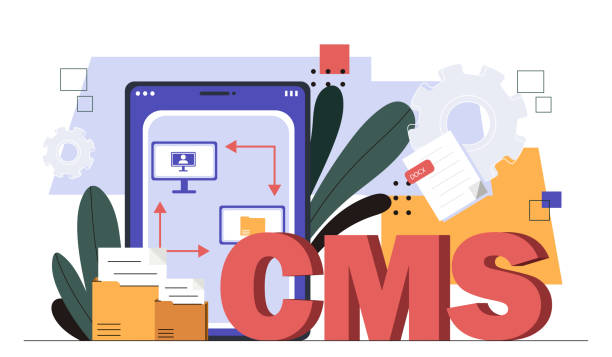Understanding Content Management Systems (CMS)

Unlocking Digital Potential: A Deep Dive into Content Management Systems (CMS)
In today’s hyper-connected world, if your business or personal brand isn’t online, it barely exists. From sprawling e-commerce empires to vibrant personal blogs, the digital landscape is built upon a foundation of content. But how is all this content – text, images, videos, interactive elements – created, managed, and published so seamlessly across billions of websites? The answer, more often than not, lies within the sophisticated architecture of a Content Management System (CMS).
For many, the term “CMS” might conjure images of WordPress, a household name synonymous with website building. However, the world of CMS is far broader and more complex than a single platform. It’s a foundational technology that empowers millions, from small business owners to enterprise corporations, to control their digital presence without needing to be a coding guru.
In this extensive guide, we’ll strip back the layers of the CMS, exploring its core purpose, delving into its operational mechanics, dissecting its diverse types, and providing a framework for understanding its critical role in the digital age. We’ll answer the fundamental question: What exactly is a CMS, and why is it indispensable for anyone looking to make their mark online?
1. What Exactly is a Content Management System (CMS)?
At its heart, a Content Management System (CMS) is a software application or a set of related programs designed to help users create, manage, and modify digital content on a website without the need for specialized technical knowledge or direct coding. Think of it as the central control panel for your website, enabling you to organize, publish, and present your digital assets with relative ease.
Before the advent of CMS, creating a website was primarily the domain of web developers. Every single page, every image, every piece of text had to be coded manually using languages like HTML, CSS, and JavaScript. Updating content meant diving back into the code, a process that was not only time-consuming but also prone to errors and inaccessible to non-technical personnel.
A CMS fundamentally changes this paradigm by separating the content from the presentation. It provides a user-friendly interface for content creators (writers, marketers, editors) to add, edit, and arrange information, while the system itself handles the complex task of storing that content and displaying it consistently across the website.
Analogy: Imagine building a house. Without a CMS, you’d be a carpenter, electrician, plumber, and decorator all rolled into one, building every brick and wire from scratch for every room. With a CMS, you’re more like an architect and interior designer. You use pre-built structures (templates), arrange furniture (content), and change paint colors (themes) through a simple interface, while the underlying construction (coding) is handled by the system itself.
2. Why Do We Need a CMS? The Core Benefits
The rapid adoption of CMS platforms isn’t just a trend; it’s a testament to the profound value they deliver. For individuals and organizations alike, a CMS offers a suite of benefits that streamlines operations, enhances creativity, and boosts overall digital effectiveness.
- Ease of Use & Accessibility: This is arguably the most significant advantage. CMS platforms provide intuitive, graphical user interfaces (GUIs) that allow non-technical users to publish and manage content. If you can use a word processor, you can likely use a CMS. This democratizes content creation, empowering more people within an organization to contribute.
- Cost-Effectiveness: While there might be initial setup costs, a CMS dramatically reduces ongoing maintenance and development expenses. You don’t need to hire a developer for every content update or minor design tweak. Open-source CMS options are often free to use, further lowering the barrier to entry.
- Streamlined Collaboration: Multiple users can work on a website simultaneously with defined roles and permissions. An editor can review a writer’s draft, while a designer uploads images, all within the same system. This fosters efficiency and reduces bottlenecks.
- Design Consistency & Brand Cohesion: Themes and templates ensure that all pages on your website adhere to a consistent design language and branding guidelines. This creates a professional look and feel without manual oversight on every page.
- SEO Friendliness: Modern CMS platforms are built with search engine optimization (SEO) in mind. They offer features like customizable URLs, meta descriptions, image alt tags, and sitemap generation, making it easier for your content to rank higher in search results. Many also have plugins/modules for advanced SEO configurations.
- Scalability & Flexibility: As your website grows, a CMS can grow with it. Whether you need to add new features, expand into e-commerce, or handle increased traffic, most CMS platforms are designed to be extensible through plugins, modules, or custom development.
- Version Control & Rollback Capabilities: Mistakes happen. A CMS often includes version control, allowing you to track changes, see who made them, and revert to previous versions of content if necessary. This is a critical safety net.
- Security & Maintenance: While not impenetrable, reputable CMS platforms actively release security updates and patches to guard against vulnerabilities. A strong community (for open-source options) often means quick identification and resolution of issues.
- Workflow Management: For larger organizations, a CMS can enforce content approval workflows. A draft might go from a writer to an editor, then to a legal reviewer, and finally to a publisher, ensuring quality and compliance.
As the digital strategist Ann Handley once aptly put it:
“Content is king, but without a powerful and intuitive CMS, that king is often without a kingdom to rule effectively.” This highlights the symbiotic relationship between great content and the system that makes it accessible and manageable.
3. How Does a CMS Work Under the Hood? A Technical Overview
While the user interface of a CMS is designed for simplicity, there’s a sophisticated operation happening behind the scenes. Understanding these technical layers provides valuable insight into the power and flexibility of these systems.
A CMS essentially orchestrates three main components:
- The Content Management Application (CMA): This is the “backend” of the CMS, the graphical user interface (GUI) that allows content creators and administrators to add, edit, publish, and manage content, users, and site configurations. When you log into WordPress, Joomla, or Drupal, you’re interacting with the CMA.
- The Content Delivery Application (CDA): This is the “frontend” that compiles and presents the content to website visitors. When someone accesses your site via a web browser, the CDA retrieves the necessary data from the database, applies the chosen site template/theme, and delivers the finished web page.
- The Database: This is where all your website’s data is stored. This includes not just your articles, images, and user accounts, but also settings, configurations, and relationships between different pieces of content.
The Request-Response Cycle
Let’s trace what happens when a user visits a page on a CMS-powered website:
- User Request: A user enters your website’s URL (e.g.,
www.example.com/blog/article-title) into their browser. - Web Server: The browser sends this request to the web server where your CMS is hosted (e.g., Apache, Nginx).
- CMS Application (Backend Logic): The web server passes the request to the CMS application (e.g., a PHP script for WordPress, a Python script for Django CMS).
- The CMS identifies which content needs to be displayed based on the URL.
- It then queries its database to retrieve the requested article title, content, author, publication date, images, etc.
- It also fetches the current website’s theme/template files.
- Data Assembly & Rendering: The CMS takes the retrieved content data and injects it into the appropriate sections of the theme/template. It processes any dynamic elements (e.g., displaying comments, related articles).
- HTML/CSS/JS Output: The CMS generates a complete HTML, CSS, and JavaScript file.
- Response to Browser: This assembled file is sent back to the user’s browser via the web server.
- Browser Rendering: The browser interprets the HTML, applies the CSS for styling, and executes any JavaScript for interactivity, finally displaying the fully rendered web page to the user.
Code Language Spotlights
To illustrate the underlying technologies, let’s look at some conceptual code snippets.
1. Database Interaction (SQL – Structured Query Language): Most CMS platforms use relational databases like MySQL, PostgreSQL, or MariaDB to store content. When an article is created, the CMS executes an SQL INSERT statement:
INSERT INTO articles (title, content, author_id, published_date, status)
VALUES ('My First Blog Post', 'This is the amazing content of my first post...', 1, NOW(), 'published');
When a user requests an article, the CMS executes an SQL SELECT statement:
SELECT title, content, published_date
FROM articles
WHERE slug = 'my-first-blog-post' AND status = 'published';
This query fetches the relevant data from the articles table based on the URL’s “slug” (a simplified, URL-friendly version of the title).
2. Backend Logic (PHP – widely used in WordPress, Drupal, Joomla): Once data is retrieved from the database, the backend language processes it. Imagine a simplified PHP script within the CMS:
<?php
// This is a highly simplified conceptual example
// In a real CMS, this would be part of a larger framework
// Assume $article_data contains the row fetched from the database
$article_data = [
'title' => 'Understanding CMS in Depth',
'content' => '<p>A Content Management System is a powerful tool...</p>',
'author' => 'Jane Doe',
'published_date' => '2023-10-26'
];
// Load the template file (e.g., single-post.php)
include 'themes/mytheme/single-post.php';
?>
The single-post.php template would then use these variables to display the content.
3. Frontend Template (HTML, CSS, JavaScript): The template files are where the fetched data is finally presented. A simplified single-post.php template might look like this:
<!DOCTYPE html>
<html lang="en">
<head>
<meta charset="UTF-8">
<meta name="viewport" content="width=device-width, initial-scale=1.0">
<title><?php echo $article_data['title']; ?> - My Site</title>
<link rel="stylesheet" href="/css/style.css">
</head>
<body>
<header>
<h1>My Website</h1>
<nav><!-- Navigation here --></nav>
</header>
<main>
<article>
<h2><?php echo $article_data['title']; ?></h2>
<p class="meta">By <?php echo $article_data['author']; ?> on <?php echo $article_data['published_date']; ?></p>
<div class="content">
<?php echo $article_data['content']; ?>
</div>
</article>
</main>
<footer>
<p>© 2023 My Site</p>
</footer>
<script src="/js/scripts.js"></script>
</body>
</html>
And a corresponding CSS snippet (/css/style.css):
body {
font-family: Arial, sans-serif;
line-height: 1.6;
margin: 0;
padding: 0;
background-color: #f4f4f4;
color: #333;
}
header {
background: #333;
color: #fff;
padding: 1rem 0;
text-align: center;
}
article {
background: #fff;
margin: 20px auto;
padding: 20px;
border-radius: 8px;
box-shadow: 0 2px 4px rgba(0,0,0,0.1);
max-width: 800px;
}
h2 {
color: #0056b3;
}
.meta {
font-size: 0.9em;
color: #666;
}
/* More styling for .content, p, etc. */
This illustrates how the backend language (PHP) dynamically injects content into a static HTML structure, which is then styled by CSS. JavaScript would handle any interactive elements like carousels, forms, or dynamic content loading.
This “separation of concerns” – where the database stores data, the backend logic retrieves and processes it, and the frontend code presents it – is the fundamental principle that allows CMS platforms to be so powerful and flexible.
4. Exploring the Diverse Ecosystem: Types of CMS
The world of CMS is not a monolith. Different architectural approaches have evolved to meet varying needs, from simplicity to extreme flexibility. Understanding these distinctions is crucial when choosing the right system.
a. Traditional (Coupled) CMS
This is the most common and historically dominant type of CMS. In a traditional (or “coupled”) CMS, the backend (content management system) and the frontend (content delivery system/presentation layer) are tightly integrated and operate as a single, unified application.
- How it works: When you create content in the admin panel, the CMS stores it in the database and then uses built-in templates and themes to render that content directly into the website that visitors see.
- Pros:
- Ease of Setup & Use: Often the quickest way to get a website online, especially for non-developers.
- “What You See Is What You Get” (WYSIWYG): Editors can see exactly how their content will appear on the live site as they create it.
- Rich Ecosystem: Large communities, abundant plugins, and extensive documentation are common.
- Full-Stack Solution: Handles everything from content creation to user management, hosting connections, and presentation.
- Cons:
- Frontend Limitations: Customizing the frontend heavily can be challenging, as you’re often working within the confines of the CMS’s templating system.
- Platform Lock-in: Migrating content or redesigning the entire frontend can be complex.
- Performance Overhead: The tight coupling can sometimes lead to slower performance compared to more streamlined approaches, as the server always renders pages dynamically.
- Less Flexible for Multi-channel Delivery: Designed primarily for web delivery, making it less ideal for delivering content to mobile apps, smart devices, or other non-web platforms without significant custom work.
- Examples: WordPress, Joomla, Drupal (in its traditional setup), Typo3.
b. Headless CMS
In stark contrast to traditional CMS, a headless CMS provides only the “body” – the backend content management and storage system – without a pre-defined “head” (frontend presentation layer). It focuses solely on content structured and delivered via APIs (Application Programming Interfaces).
- How it works: Content is created and managed within the headless CMS, just like any other, but instead of rendering it into a website, it exposes the raw content data through APIs (typically RESTful or GraphQL). Developers then use these APIs to pull the content and display it on any frontend they choose, whether it’s a website built with React, Vue, or Angular, a mobile app (iOS/Android), an IoT device, or a smart speaker.
- Pros:
- Ultimate Flexibility: Developers have complete freedom over the frontend technology stack and design.
- Multi-channel Content Delivery: Content can be pushed to any platform or device that can consume an API (web, mobile, smartwatches, voice assistants, digital signage).
- Enhanced Performance: Frontends can often be optimized for speed, as they only fetch the data they need and can be built as static sites (JAMstack).
- Future-Proof: Easier to swap out frontend technologies without affecting the content backend.
- Improved Security: Separating the frontend from the backend can reduce attack vectors.
- Cons:
- Higher Technical Expertise Required: Requires developers to build the frontend from scratch.
- No WYSIWYG: Content creators don’t see the final rendered output within the CMS. They need separate preview environments.
- Increased Complexity: Managing two distinct systems (CMS backend and custom frontend) can be more complex.
- More Development Time/Cost: Initial development can be more extensive.
- Examples: Contentful, Strapi, Sanity, DatoCMS, ButterCMS.
c. Decoupled CMS
A decoupled CMS sits somewhere between traditional and headless. It has a default, integrated frontend but also exposes its content via APIs, allowing developers to build custom frontends if desired. It offers the best of both worlds, providing a default coupled experience while retaining the flexibility of a headless system.
- How it works: It offers a standard frontend for those who want it (like a traditional CMS) but also provides APIs for developers to create completely separate, custom frontends. This means you can use the built-in templating system for most of your site, but build a highly interactive section or a mobile app using its API.
- Pros:
- Flexibility & Ease: You can use the integrated frontend for rapid development while having the option to go custom where needed.
- Hybrid Approach: Benefits from both traditional and headless models.
- Scalability: Can serve diverse presentation layers.
- Cons:
- Can be more complex: Managing both integrated and custom frontends.
- Potentially higher learning curve: For developers who need to understand both templating and API usage.
- Examples: Drupal (often used in a decoupled fashion with React/Vue frontends), dotCMS, Adobe Experience Manager.
d. SaaS / Cloud-Based CMS
Software-as-a-Service (SaaS) CMS platforms are hosted and managed entirely by a third-party provider. You access the CMS through a web browser, and the provider handles all the underlying infrastructure, security, and maintenance. These can be traditional, headless, or decoupled in their architecture but are defined by their delivery model.
- How it works: You subscribe to a service (often monthly), and the provider gives you access to their CMS. You don’t need to worry about servers, updates, backups, or security patches – it’s all handled for you.
- Pros:
- Zero Infrastructure Management: No need to buy servers, install software, or manage updates.
- Ease of Use: Often designed for maximum user-friendliness.
- Scalability & Reliability: Providers handle traffic spikes and ensure uptime.
- Automatic Updates & Security: Always on the latest version with current security measures.
- Predictable Costs: Monthly subscription model.
- Cons:
- Less Control & Customization: Limited by the features and design options offered by the provider.
- Vendor Lock-in: Migrating your content to another platform can be challenging.
- Dependency on Provider: Rely on the provider’s uptime and service quality.
- Subscription Costs: Can be more expensive long-term than open-source self-hosted solutions, especially for complex needs.
- Examples: Squarespace, Wix, Shopify (e-commerce focused), Webflow, Contentful (also a headless CMS, but delivered as SaaS).
e. Open Source vs. Proprietary CMS
This is a distinction based on the licensing and availability of the CMS’s source code.
- Open Source CMS: The source code is freely available to the public, allowing anyone to view, modify, and distribute it.
- Pros: Free to use, vast communities, high flexibility, no vendor lock-in.
- Cons: Requires technical expertise for hosting and maintenance, security relies on community vigilance, support can be community-driven (less formal).
- Examples: WordPress, Drupal, Joomla, Strapi (some editions).
- Proprietary CMS: The source code is owned by a company, and users must pay for licenses to use it.
- Pros: Dedicated professional support, often highly polished with specific features for enterprise, strict quality control.
- Cons: High licensing costs, vendor lock-in, limited customization options, often slower innovation for core features.
- Examples: Adobe Experience Manager (AEM), Sitecore, Kentico.
5. Essential Features of a Robust CMS
While specific features vary depending on the CMS type and target audience, a truly robust and effective CMS will generally possess a core set of functionalities that empower users and developers alike.
- Content Creation & Editing Tools (WYSIWYG):
- An intuitive editor (like a word processor) to create and format text.
- Support for rich media (images, videos, audio embeds).
- Often features a “What You See Is What You Get” (WYSIWYG) editor, allowing users to see exactly how their content will look on the live site.
- Code-wise: These editors usually output HTML tags (e.g.,
<p>,<strong>,<em>,<ul>) based on user selections.
- Media Management:
- Upload, organize, and manage images, videos, documents, and other files.
- Image resizing, cropping, and optimization tools.
- Categorization and tagging for easy retrieval.
- Code-wise: Stores file paths in the database and manages actual files on the server’s file system, often generating different image sizes on upload.
- User Management & Permissions:
- Create and manage user accounts with different roles (e.g., administrator, editor, author, subscriber).
- Granular control over what each role can view, edit, publish, or delete.
- Code-wise: User data stored in the database; role-based access control (RBAC) logic checks permissions before allowing actions.
- Workflow & Version Control:
- Define content approval processes (e.g., draft -> pending review -> published).
- Track revisions of content, allowing users to revert to previous versions.
- Code-wise: Stores multiple versions of content data in the database, often with timestamps and user IDs for each revision.
- SEO Tools:
- Ability to customize page titles, meta descriptions, and URL slugs.
- XML sitemap generation.
- Integration with analytics tools (Google Analytics).
- Support for schema markup.
- Code-wise: These fields are stored in the database and then output as
<meta>tags in the HTML<head>section of the rendered page.
- Extensibility (Plugins/Modules/Extensions):
- A framework for adding new functionalities without modifying the core CMS code.
- A marketplace or repository of plugins (e.g., WordPress plugins, Drupal modules).
- Code-wise: A well-defined API/hook system that allows third-party code to interact with and extend the CMS’s core functionality.
- Templating & Theming:
- A system to define the visual appearance and layout of the website.
- Ability to switch themes easily.
- Customization options for colors, fonts, and layouts.
- Code-wise: Uses template files (HTML mixed with backend logic) and CSS/JavaScript files to control presentation.
- Security Features:
- Robust authentication (password hashing, multi-factor authentication).
- Protection against common web vulnerabilities (SQL injection, XSS).
- Regular security updates and patches.
- Code-wise: Implements secure coding practices, input validation, output escaping, and integrates with security libraries.
- Scalability:
- Ability to handle increasing amounts of content and user traffic.
- Support for caching, content delivery networks (CDNs), and database optimization.
- Code-wise: Designed with modularity, efficient database queries, and caching mechanisms to handle high loads.
- Multilingual Support:
- Capability to manage content in multiple languages.
- Translating interface elements and content.
- Code-wise: Stores content in multiple language versions, often with specific routing or subdomain configurations.
Table: CMS Type Comparison Overview
| Feature/Aspect | Traditional (Coupled) CMS | Headless CMS | SaaS/Cloud-Based CMS |
|---|---|---|---|
| Ease of Setup | Very High (often guided installers) | Moderate to High (requires dev setup for frontend) | Very High (no installation) |
| Technical Expertise | Low (for content creation), Moderate (for dev) | High (requires frontend developers) | Low (user-friendly interfaces) |
| Frontend Control | Limited (via themes/templates) | Absolute (can use any frontend tech) | Limited (via builder/pre-set options) |
| Multi-channel | Challenging (primarily web) | Excellent (API-driven to any device) | Moderate (may have limited built-in mobile options) |
| Performance | Can be good, but often dynamic rendering overhead | Excellent (can build highly optimized frontends) | Varies by provider, usually good |
| Cost Model | Free (open source core) + hosting/dev costs | Free (open source core) + hosting/dev costs or SaaS fees | Monthly/Annual Subscription |
| Maintenance | Self-managed (updates, security) | Self-managed (backend) + frontend maintenance | Fully managed by provider |
| Scalability | Good, but can require specialized hosting/dev | Excellent (backend/frontend can scale independently) | Excellent (handled by provider) |
| Key Use Cases | Blogs, standard websites, small e-commerce | Enterprise, complex apps, multi-channel experiences | Small business websites, portfolios, basic e-commerce |
| Examples | WordPress, Joomla, Drupal | Contentful, Strapi, Sanity | Squarespace, Wix, Shopify (e-commerce) |
6. Choosing the Right CMS for Your Needs: A Strategic Approach
Selecting the ideal CMS is a critical decision that can impact your digital strategy for years to come. There’s no one-size-fits-all answer; the “best” CMS is the one that best fits your specific requirements, resources, and long-term goals. Here’s a strategic approach to guide your choice:
- Define Your Goals & Requirements:
- What kind of website are you building? (Blog, e-commerce store, corporate site, portfolio, web application, mobile app?)
- What content will you manage? (Text, images, videos, products, user-generated content?)
- What features are absolutely essential? (User registration, payment gateway, multilingual support, advanced search?)
- What’s your growth forecast? (Do you anticipate massive traffic or feature expansion?)
- Assess Your Team’s Technical Expertise:
- Content Creators: Do they need a WYSIWYG editor? How tech-savvy are they?
- Designers: How much creative control do they need over the frontend?
- Developers: Do you have in-house developers? What languages/frameworks are they proficient in? Are you comfortable building a custom frontend?
- If your team is non-technical, a traditional or SaaS CMS is preferable. If you have strong frontend developers, a headless or decoupled approach opens up possibilities.
- Consider Your Budget:
- Initial Costs: Licensing fees (for proprietary), development time, setup.
- Ongoing Costs: Hosting, maintenance, security, updates, plugin subscriptions, developer support.
- Open-source options can be free for the core software but incur costs for hosting, customization, and expert help. SaaS models have predictable monthly fees.
- Evaluate Scalability and Performance:
- Will your chosen CMS handle sudden spikes in traffic?
- Can it accommodate a vast amount of content and users as you grow?
- How will it perform under load? (Look for caching, CDN support, and efficient underlying architecture).
- Security Considerations:
- How actively is the CMS maintained and updated for security?
- What security features are built-in (e.g., user authentication, data encryption)?
- What is the community’s track record for addressing vulnerabilities?
- Ecosystem and Community Support:
- How large and active is the community around the CMS? This translates to more resources, tutorials, plugins, and quicker problem-solving.
- Are there readily available developers or agencies familiar with the platform if you need external help?
- For proprietary CMS, what level of official support does the vendor offer?
- Integrations:
- Does the CMS integrate well with other tools you use (CRM, marketing automation, analytics, payment gateways)?
- Can you easily connect custom third-party services?
As technology author and consultant Jeffrey Zeldman advises:
“The best CMS is the one you don’t notice, because it just works, allowing you to focus on creating and connecting.” This emphasizes that the right CMS should be a tool that empowers, not hinders, your mission. It should fade into the background, letting your content and user experience shine.
7. The Future of CMS: Innovation on the Horizon
The CMS landscape is dynamic, constantly evolving to meet new technological advancements and user expectations. Several key trends are shaping its future:
- AI and Machine Learning Integration:
- Content Creation & Optimization: AI assistants for generating content ideas, optimizing headlines, or suggesting keywords.
- Personalization: ML algorithms analyzing user behavior to deliver highly personalized content experiences, automatically.
- Accessibility: AI-driven tools to automatically generate image alt texts, video captions, or check content for accessibility compliance.
- Predictive Analytics: Forecasting content performance or user engagement.
- Hyper-Personalization and Contextual Experiences:
- Moving beyond basic personalization, CMS platforms will offer deeper contextual delivery, understanding user intent, location, device, and even mood to present truly relevant content.
- Adaptive content that changes based on user interactions in real-time.
- Further Adoption of Headless and Decoupled Architectures:
- The demand for multi-channel content delivery (web, mobile, IoT, voice) will continue to drive the adoption of API-first approaches.
- Frontend frameworks like React, Vue, and Svelte will become even more prevalent in building highly interactive and fast digital experiences on top of headless CMS backends.
- Voice and Conversational Interfaces:
- CMS platforms will need to adapt to serve content seamlessly to voice assistants (Alexa, Google Assistant) and chatbots.
- Content will need to be structured and tagged in a way that makes it easily consumable by these interfaces.
- No-Code/Low-Code and Visual Development:
- Building on the ease-of-use principle, further advancements in visual builders will empower even non-technical users to create sophisticated layouts and functionalities without writing a single line of code.
- Webflow is a prime example of this trend, blurring the lines between CMS and design tool.
- Serverless CMS & Edge Computing:
- Hosting CMS platforms on serverless architectures (like AWS Lambda or Google Cloud Functions) can offer enhanced scalability, reduced operational costs, and improved performance.
- Edge computing will push content closer to the users, reducing latency and speeding up content delivery.
- Blockchain for Content Ownership and Authenticity:
- While still nascent, blockchain technology could play a role in verifying content authenticity, tracking ownership, and potentially even monetizing content in novel ways.
These trends indicate a future where CMS platforms are not just repositories for content but intelligent, adaptable, and omnipresent engines driving digital experiences across an ever-expanding array of devices and interactions.
8. Conclusion: The Indispensable Digital Engine
The Content Management System is far more than just a piece of software; it’s the fundamental engine driving the modern digital world. From the simplest blog to the most complex e-commerce platform or enterprise application, CMS empowers individuals and organizations to harness the immense power of online content.
We’ve traversed the landscape of CMS, from its basic definition as a tool for separating content from presentation, through its core benefits of accessibility and efficiency, and into the technical intricacies of its backend operations. We’ve explored the diverse ecosystem of traditional, headless, decoupled, and SaaS CMS, each offering unique advantages for different use cases. Finally, we’ve outlined the critical features that define a robust system and provided a strategic framework for choosing the one that aligns with your specific needs, all while peering into the exciting future that awaits this essential technology.
Whether you’re a seasoned developer, a budding entrepreneur, or a passionate content creator, understanding Content Management Systems is no longer optional – it’s a prerequisite for thriving in the digital age. By selecting and leveraging the right CMS, you’re not just building a website; you’re constructing a powerful, flexible, and future-ready platform for your digital voice, vision, and growth. The digital kingdom awaits, and with a robust CMS, you have the crown jewels to rule it.





